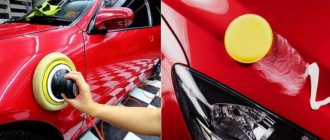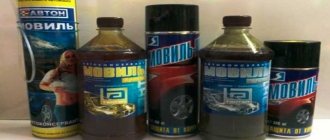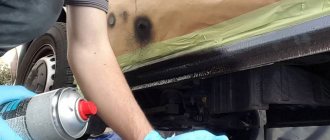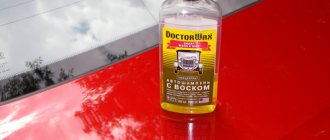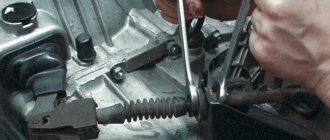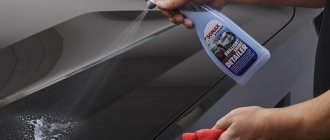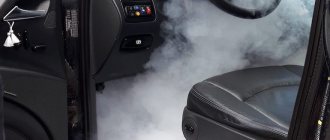Recently, car wax has become an integral part of protecting its varnish. As you know, even wiping the surface of a car body with a dry cloth causes certain damage to its condition, forming microscopic scratches into which water, dust and dirt easily penetrate. The chemicals used during the washing procedure also pass into these holes, corroding the varnish layer and acting as sanding material for its surface.
To reduce the wear and tear of the car’s appearance, modern methods of protecting the car body are used, including waxing
A liquid hydrophobic substance has become a solution to this problem, since after it is applied to the car body, an additional waterproof layer appears. This layer is a kind of barrier; it repels dirt molecules with its entire surface, thus preventing the formation of new cracks. As experts note, it is possible to cover both an old type of transport and a new one with a dust-proof layer. Moreover, liquid wax for a car that has just rolled off the assembly line will provide reliable protection for more than one month.
Based on the above, waxing a car is necessary so that the vehicle acquires its original shine, to reduce the time for car washing and drying processes, to protect against the penetration of dust and the harmful effects of ultraviolet rays.
Hot wax, what it is, how it is applied to the car body
Separately, I would like to dwell on such a popular service offered by most car washes as coating the body with hot wax. What is it, what are the advantages of this particular method of waxing?
It may be a mistake to assume that coating with liquid wax and hot wax are the same thing.
But actually it is not.
For hot wax coating, waxes with a completely different composition are used, forming a much more resistant hydrophilic film on the car body, thereby providing not only an excellent shine to the paintwork, but also good protection from the effects of an aggressive environment.
By applying wax in a heated state, the entire surface of the body is uniformly covered with microfilm, creating a preservative protective effect.
The wax film after such a coating ensures faster drying of the car, for example, after rain, due to the hydrophilic properties of the wax coating.
DIY hot wax treatment
Hot wax treatment can be done independently, but due to the specifics of the technological process, it is better to entrust this procedure to specialists.
However, if you decide to treat your car with hot wax yourself, be sure to acquire a high-quality composition.
Of the most popular waxes, you should pay attention to NERTA HOTWAX, Red Penguin, GRASS Hot Wax or hot wax RM 820 ASF, which must be diluted with hot water (60-70 C°) for application.
This hot wax can be applied either from a sprayer (including using high-pressure washers) or with a regular sponge.
When covering a car with hot wax yourself, it is important to apply the composition very carefully to the entire body, without leaving any gaps.
Also, do not forget to wipe the cars after applying the composition; it is preferable to use a suede cloth for this, this will increase the shine of the wax coating, since wiping with a suede cloth creates a polishing effect.
hot wax shampoos
It is also worth paying attention to shampoos containing hot wax, for example Turtle Wax Hot Wax.
Such a universal product will significantly reduce the time it takes to wash a car, but the quality of the protective wax layer will not be affected.
For application, this product is also diluted with hot water according to the proportions indicated on the packaging and then applied to the car body.
After application, the car is rinsed with water and wiped with a suede cloth.
Regardless of what type of wax you choose, and despite all the benefits described, you still shouldn’t overuse waxing your car.
Some people do this treatment after every wash, which is actually not very good.
By forming a multi-layer wax film, wax, of course, protects the paintwork, but on the other hand, it also clogs the “pores” creating a “greenhouse effect” and affects the paintwork, changing its properties.
Therefore, you should resist the temptation to wax your car after every wash.
The frequency of waxing depends on the type of wax used.
When using spray wax, you can repeat the treatment after 1-2 washes, when using liquid wax - once a month, when treating with hard wax - once every 2-4 months, after treatment with synthetic or hot wax, re-treatment should be carried out no earlier than after 4-6 months (depending on the frequency of washing the car).
Excessive use of wax can lead to clouding of the paintwork and even peeling of the varnish.
Fast, but not for long
Wax actually protects the car's finish. A thin film prevents moisture from penetrating through chips and microcracks in the paint to the metal body panels. It returns shine to the varnish and visibly updates the car. In addition, wax-based chemicals help hide minor paint defects. The wax layer also protects from ultraviolet rays. The chemical film also has water-repellent properties, and when it rains, moisture can be seen beading up and flowing off the body, leaving it dry.
Question answer
How to properly remove insect stains from a car body?
True, not every wax coating leads to these wonderful results.
There are different types of wax products: liquid, solid, synthetic and spray. The car wash offers wax sprayed under pressure from a gun. In addition, this spray is also sold in cans for self-use. The spray applies quickly and does not last long. After a couple of days, almost half of the coating is washed off by rain or peels off under the abrasive action of dust and wind. Within a week, not a trace remains of the thin film of wax. Therefore, for a long-term effect, it is necessary to apply wax after each wash.
This is interesting: Where is the Mazda 3 valet button?
Making the right choice between shine and protection
If you just want to add shine to the car body, you can use polishes containing silicone particles. But the shine of the paintwork and its protection are two different concepts. Therefore, you should not trust those manufacturers who promise both shine and high-quality protection of the car’s paintwork for a long time. Due to its properties, silicone not only does not protect the car from dust and stones, but is also capable of damaging the layer of wax previously applied to the vehicle. In the end, one thing will happen: either the car will simply shine, or the paintwork will simply be covered with an invisible layer of protection.
Application
As mentioned, it is possible to apply all types of wax by hand, with the exception of foam. In any case, before creating the coating, it is necessary to clean the body of dirt by washing. Washing should be done using a non-contact method.
Waxing should not be done in the sun. You must first shake the composition thoroughly. Self-treatment of a car with liquid wax consists of applying it to a body surface that has not dried after washing and rubbing it with a napkin or rag.
It should be noted that liquid wax is often included in the cost of washing or is offered as an additional service at a low cost. However, the feasibility of using this material is questionable, since this service increases the cost of washing, and in order to maintain the effect it is necessary to repeat this operation every time. This explains the low cost of washing a car with this wax, which is 1-2 dollars.
Hard wax car body treatments at car washes range from $12 to $250. This difference in cost compared to liquid wax is explained by more complex application technology. In addition, the materials have a high cost, which can reach $500 per jar of hard wax.
It should be noted that liquid wax and spray versions are much more widespread compared to hard and synthetic wax. This is explained, first of all, by the high cost of applying the latter to the car body. Naturally, such wax is not intended for general use. It is usually used for expensive cars to protect them from damage to the paintwork. Treating cars with such wax on your own is also rarely used, due to the complexity of this process. Washing your car with car shampoo containing wax or applying liquid material is naturally much easier.
- Wash with warm water mixed with shampoo in one container and plain water in the other.
- You need to wash in one direction - from top to bottom.
- To increase the efficiency of cleaning the car body during the washing process, you should wash it with a sheepskin glove, as it is a more effective cleaning tool compared to the various sponges usually used for this purpose.
- It is advisable to wash the body and wheels with different sponges.
- It is not advisable to wash your car with products based on silicone, as well as those containing alkalis or acids.
3. Hard water.
4. Poor quality detergents.
And, of course, this polish copes well with road dust, sand, small stones and other elements of the road surface.
By its nature, hot car wax is a fat-like substance that can be either synthetic or natural. This product melts at temperatures from 40 to 90 degrees Celsius. Most often, famous manufacturers add this to their products. This is the highest quality type of wax, which has excellent protective characteristics. Carnauba is almost completely transparent, hard and has a high melting point, and accordingly, it stays on the paintwork longer.
Useful tips
Below are some tips for washing your car:
- To wash your car, you need to prepare two containers: one with warm water and shampoo, and the other with clean water.
- Wash in one direction: from top to bottom.
- In order for waxing a car body to achieve the desired effect, you need to thoroughly wash the surface. A sheepskin glove is ideal for this because it removes dirt more effectively than a sponge.
- You need to have different jaws for the body and wheels.
- It is highly undesirable to use substances containing silicone or alkali for washing.
Car enthusiasts who visit specialized car washes have often heard proposals for additional waxing of their car.
Many agree, which, of course, they do not regret at all. The car becomes not only clean, but also extremely bright, especially in the shimmer of sunlight.
Today we will talk about what the waxing process is, what types of wax exist, and also highlight their main advantages and disadvantages.
How to apply wax and when is the best time to do it?
Each type of wax has its own advantages and, in principle, to achieve an optimal effect, you can alternate the use of different types of wax.
For example, for the winter period it is worth using synthetic wax, as it will provide the most durable protection against the effects of water and especially salt and other aggressive substances sprayed on roads to combat icing.
In the summer, you can give preference to treating the body with solid or liquid wax.
When using liquid wax, do not forget to repeat this procedure regularly.
It is also worth mentioning that there are many modern car shampoos that contain wax.
Regular car washing with such shampoos will not only improve the appearance of the car, but will also protect the body from moisture, synthetic and natural substances, resins and oils.
In addition to protecting against corrosion, waxing also prevents paint fading and provides minor protection against mechanical damage.
Summarizing all of the above, it is logical to conclude that waxing extends the service life of a car’s paintwork.
Waxing also facilitates the process of removing contaminants from the car body, including difficult-to-remove substances such as tar and oil.
Types of waxes for cars
Car waxes are polishes with the addition of carnauba resin. Its distinctive feature is the fact that it is the most refractory wax of natural origin. In particular, it preserves the protective film at temperatures from +83°C to +91°C. It is absolutely non-toxic and harmless, which is why it is also used in the food industry (for example, grating apples to make them shine in a display case). It is also harmless to the paintwork of the car. Thus, polishes with the addition of carnauba wax are also called natural.
Another type of wax is synthetic. It contains synthetic waxes and paraffins. They may not have such a neutral attitude towards paintwork (that is, over time, its surface may fade). However, their undoubted advantage is their more durable film, which does not wash off from the surface of the car body for a long time.
There are four types of waxes based on the method of application:
- liquid (another name is fast);
- solid;
- hot;
- shampoo with wax.
Thus, liquid or quick waxes are based on a synthetic base, and are most popular due to the ease of their application to the surface being treated. As a rule, they are produced in the form of a trigger with a manual sprayer. Accordingly, before application, the surface must be thoroughly cleaned (washed and dried), and then waxed and polished using a rag, napkin, microfiber or other similar materials. However, sometimes there are liquid waxes that need to be applied to a damp, clean paint surface.
Hard waxes are essentially polishing pastes. And they most often have a natural base, since they are made from carnauba wax. Due to their naturalness, their compositions have a more lasting effect (however, this largely depends on the specific manufacturer and brand). Hard waxes are applied to the surface to be treated using a special sponge applicator (as a rule, it comes directly with the wax packaging). Before use, the said sponge is moistened with water and wrung out. This is done so that the wax does not stick to the sponge and is applied to the paintwork in an even layer. Some hard waxes are used not only to make the body shine, but also to restore the paintwork, similar to special anti-scratch agents for car bodies.
Hot wax is a combination composition that includes shampoo and polish. Accordingly, this product simultaneously cleans the surface being treated and protects it. It got its name because the contents of the package must be dissolved in hot water before use. Well, the resulting mixture is used to directly wash the car’s paintwork. This is precisely the difference between hot and cold car wax.
As for car shampoo with wax, it is also usually dissolved in water. Before use, you must carefully read the recommendations on the packaging.
It is important to know to what concentration to dilute the wax, and also to dissolve the concentrate in cold or hot water
What determines the durability of wax?
Most modern products indicate directly on the packaging how many car washes the wax composition can withstand. However, there is a nuance here, which is that when used in reality, a different result may be obtained. And the reason for this lies, among other things, in the hardness of the water. And this indicator depends on the specific geographic region where the car is used. The softer the water (it contains fewer metal salts and other impurities), the longer the wax lasts. And if hard water was used along with the wax (or before applying it), then the duration of use of the wax composition will be less than stated on the packaging.
Similar reasoning is also valid for the case when harmful substances are directly in the air in the area where the car is used. An example of such a situation would be if a car owner lives in close proximity to the sea, various production or mining enterprises, as a result of which substances harmful (specifically to the paintwork of the car, but also to human health) are released into the air. Accordingly, the more there are, the shorter the period of the applied coating will be.
The next factor affecting durability is the proper preparation of the body paint. First of all, you need to wash it thoroughly, preferably in a car wash using special brushes (or maybe several times). To remove dirt from microcracks in paintwork, special plasticine is used (if you do the cleaning yourself). At car washes this service is offered additionally. The quality of cleaning directly affects the durability of the wax.
Let's sum it up
At the end of the article, we will say that coating the surface of a car body with wax must be carried out in conjunction with other preventive measures - washing, anti-corrosion treatment, polishing, etc.
It is the paint layer that suffers first when operating a car. The car owner’s task is to protect it as much as possible or at least minimize the destructive effects of harmful environmental factors.
The more the driver pays attention to this, the longer the car will maintain its original appearance, without the formation of microcracks in the paint layer and, as a result, without the formation of corrosion.
What types of liquid wax are there?
It comes in the following types:
Wax spray. It is not very difficult to apply, but its disadvantage is that it will not last long on the coating.
Liquid wax. This wax is applied with a piece of cloth and rubbed over the entire surface. This type of protection will last longer than the previous type.
Hard wax. It is difficult to apply, but it provides reliable protection for up to six months.
Synthetic wax. This coating is the most durable and reliable type of protection. It often does not need to be applied; once every 5-6 months is enough. This wax contains compounds found in shampoos.
Depending on the type of wax, the technological process for applying it is used:
Cold wax. Since this substance is liquid, it should be applied manually, then only after washing the car. It contains CAB and an emulsifier.
Hot wax. This transparent substance is very resistant to wear. This substance melts at a temperature of approximately 40-90 degrees. It must first be melted with hot water, and then manually applied to the vehicle body and polished. Hot wax contains a corrosion inhibitor.
Wax foam composition. This emulsion should be applied using special equipment. The foam adheres firmly to the surface and creates an even polish.
Question No. Natural or synthetic?
All waxes, from cheap to expensive, can be divided into two groups: natural and synthetic.
Natural waxes, as the name suggests, are made from natural ingredients. The base is almost always wax obtained from the leaves of the carnauba palm. In addition, beeswax, almond oil or even Aloe Vera are often used.
Synthetic waxes are produced artificially. Sometimes both types are mixed, some call it "hybrid wax".
What is important: is natural wax better? Not a fact, but, as a rule, natural waxes are more expensive.
In addition, as we said above, you can distinguish between the type of hard wax and spray. The former take longer to apply manually, but spray waxes last less.
Advantages
The paintwork shines well after treatment;
The protective wax film does not allow the coating to deteriorate;
A car covered with it washes better;
Dries faster.
Well protects paintwork from pollution, chemicals and UV rays.
The use of the car is reflected in the external paintwork: the enamel becomes dull, chips appear, and cracks eventually turn into deeper flaws. Car owners who want to get rid of such problems often resort to using car polish, which only “rubs” the eye and produces a temporary effect. Is it worth wasting money? It is much more practical to use protective wax instead of conventional products.
By coating your car with wax, you get a protective layer over the varnish enamel, which results in the following benefits:
- protects microcracks and chips from water, snow, ice, dirt and other chemicals;
- removes remaining chemicals after washing;
- adds additional shine to paintwork;
- fills scratches and chips, creating a smooth surface;
- updates the appearance of the car;
- protects the car from ultraviolet light.
When choosing car wax, you should keep in mind that this polish has the qualities of a certain type of protection. The purchase of wax is characterized by:
- ease of processing;
- repellent and restoration properties;
- duration of operation.
Expected effect
Not everyone fully understands why waxing cars and what effect can be obtained from such a procedure.
In fact, such processing is not considered mandatory, and it is performed purely at the request and personal initiative of the motorist. But if you understand what this wax is for and what it does to the car body, many will change their attitude towards the product and want to use it themselves.
Like all elements, paintwork has a limited service life. Gradually, the paint becomes duller, and damage and cracks form on the surface of the paintwork. In many ways, this can already give many an answer to the question of why to cover your car with special wax.
Such auto chemical products help eliminate:
- scratches;
- chips;
- microcracks.
Let's take a closer look at what wax does when washing a car. The substance, distributed over the surface of the body, fills all defects and microcracks. This allows you to create a flat and smooth surface.
Wax has hydrophobic properties, forming a kind of film when the substance hardens. Additionally, the paintwork becomes brighter and more shiny.
The created coating has decent protective characteristics. It helps to minimize the negative impact from:
- ultraviolet radiation;
- car detergents;
- mud;
- dust;
- chemical reagents, etc.
To ensure maximum effect, it is recommended to apply the product in at least 2 layers.
As for whether it is necessary to wipe your car immediately after applying a layer of wax, it depends on the specific product chosen and the instructions for use provided for it.
This is interesting: Is it possible to tow a car with an automatic transmission with the engine not running?
Types of wax
There are three classifications of car wax.
One of them is based on the properties of the substance. In accordance with it, the following types of wax are distinguished:
- in the form of a spray;
- liquid;
- solid;
- synthetic.
Spray is considered the least attractive option. This is due to its low stability. This wax is washed off from the car body in a couple of washes. Therefore, this coating will have to be applied very often, although this process is simple.
Liquid wax is more stable compared to the type discussed above. The technology for treating a car with it consists of applying the substance to a washed body and rubbing it.
Synthetic wax is the most stable, and this coating lasts up to six months. Moreover, it is easy to apply, as it is presented in liquid form. This substance is also included in some car shampoos.
Another classification of car wax is based on application technology. It includes the following types:
- cold;
- hot;
- foamy.
Cold wax is a liquid containing large quantities of cationic surfactants and emulsion wax. Application of such coatings is carried out manually. The disadvantage of this material is its low durability. To maintain the effect, repeat the coating process after each wash.
Hot wax is a fat-like substance of artificial or natural origin. Its melting point is about 90ºС. Carnauba wax is considered one of the highest quality waxes. This is explained by the fact that it is completely transparent, has a high melting point and is highly resistant to wear. This material retains its properties for six months to a year. Many substances of this type contain corrosion inhibitors.
Foam wax is similar in properties to hot wax, but the difference lies in the application technology. The creation of the coating in question cannot be done manually, since this process involves the use of special equipment. It is necessary to create a foam emulsion by introducing air into a mixture of wax and water. The use of such complex technology is justified by the high degree of adhesion of the foam emulsion to the working surface and its uniform polishing.
Another classification of waxes is based on origin. According to this criterion, the materials under consideration are divided into the following varieties:
- synthetic;
- mineral;
- animals (bees);
- vegetable (carnauba).
It should be noted that the properties of these types of wax are similar, so this feature is rarely taken into account when choosing.
Varieties
Wax is a polymeric substance that comes in several forms and is offered under a variety of brands. Each company has its own production technology and list of components added to the composition.
It is difficult to objectively say which wax is best to cover your car, since each of them has its own significant list of advantages.
Car wax is usually classified according to 3 main characteristics:
- method of application;
- compound;
- form of production.
If we talk about the form of release, here are the following options:
- spray;
- liquid composition;
- solid consistency.
Most often, motorists are interested in which wax is best to use for a car - solid, liquid or in the form of a spray.
No less pressing is the question of the optimal method of application.
According to this classification, car wax is:
- hot;
- cold;
- foamy.
According to the release form, as mentioned, it is liquid or solid. Spray is used much less frequently. The product is suitable for independent use.
If we take the composition as a basis, then car wax is divided into 4 basic categories. They can be:
- mineral;
- synthetic;
- animals;
- vegetable.
Each of them has its own characteristics and nuances. To choose or understand how to make car wax yourself, you need to look at their strengths and weaknesses.
- Cold car wax. Consists of a group of liquid components. Apply to the surface manually. The coating is removed after washing the car. To maintain the protective properties, the mixture must be constantly applied. It is best to do this after washing. The disadvantages include short-term effects, which means you have to spend a lot of money.
- Hot wax. Its shape resembles fat. This car wax can be natural or artificial. The composition usually includes corrosion inhibitors that can improve protective properties. After application, the composition retains its functions for about a year. Hot waxing is expensive, but requires little material. The main disadvantage is the temperature at which the mixture must be melted. This is about 90 degrees Celsius. The minimum time between hot wax treatments is 6 months.
- Liquid composition. Liquid waxes are used for self-application. The main advantage is the long-lasting effect and ease of use. The duration of exposure is superior to sprays, but inferior to solid analogues.
- Hard wax. It is characterized by long-lasting effects when compared with analogues. It is quite expensive, but can retain its properties for up to six months. The quality is second only to synthetic waxes. When applying solid products, be sure to dry the surface of the body. Quite difficult to process.
It is worth noting that the hard type of wax is a type of cold protective agent.
Choose wax Pay attention to the color of your car
This may sound strange, but when choosing a wax polish, you also need to base your choice on the color of the car. Many users do not know what wax to apply to a white car body, they are at a loss and make a bad choice. But it is on snow-white cars that the negative influences of the environment are clearly visible. So, auto chemicals for a white car need appropriate chemicals, with the following set of features:
- providing the coating with a brilliant shine;
- guaranteeing long-term and reliable protection;
- preventing dust from settling;
- color enhancement.
A very good product for caring for white cars is wax from Chemical Guys. That's what it's called - White. Not inferior to it is Turtle Wax T-6A, which works best on white cars.
But for this you should choose completely different products. The first thing you need to consider is the possibility of purchasing Turtle Wax Black Box. After using it, there are no scratches, swirl marks or other troubles left on the car. Pinnacle Souveran and Black Velvet Wax with carnauba wax show good results.
We understand the types of wax auto chemicals
There are several types of wax on the car care market. Not all of them are equally good, easy to apply and long lasting. In addition, do not forget why wax is applied:
- preserve paint and varnish on the car;
- protect the car from external factors;
- formation of a reliable protective film;
- corrosion protection.
So let's figure out what kind of wax is best to cover your car so that it not only shines, but is also reliably protected and thoroughly prepared for further use.
- Wax spray
It was not without reason that we initially chose this option so as not to mention it again in the future. This is the worst example that exists. Even its light application does not do it any favors. Wash the car several times or get caught in the rain - this will be enough for not a trace of the wax coating to remain. And again you will have to treat the surface of the car.
- Liquid
The next type of car wax product is already worth the user's attention. Its application requires more effort, time and effort, but the result will please you for a long time. From a clean car, it is necessary to remove the accumulated water and apply liquid wax. We wait about three minutes and wash off all excess with water. All that remains is to blow it with air and thoroughly rub the car to a sparkling shine.
- Solid
If you apply hard car wax correctly, it will last about three months. You can find another name for this substance - hard wax. Application is carried out only on a dry and clean surface; it requires careful polishing or, in other words, rubbing a waxy substance into the surface of the car.
- Synthetic
A common type of car protection product, which is even included in other car care products. It has a liquid structure, is easy to apply, and lasts a long time (up to six months).
Experts advise using a waxy substance of synthetic origin for winter, and a solid or liquid wax polish in summer.
- Hot
This type of wax creates a pronounced shine on the surface of the car. The protective properties are also excellent. It must be used together with hot water. If you are tormented by thoughts about whether to choose hot or cold wax, then it is better to go with the first option.
Here it is extremely important to choose, for example, Turtle. This wax has been tested by many users who were satisfied with the results.
Car care products from Doctor Wax
Doctor Wax is an American brand of budget car care products aimed at Eastern European markets. Car enthusiasts give these waxes mixed reviews. Their affordable cost, good shine and low stability are noted. A good option if you don’t want to spend too much on car cosmetics. Please note the following products:
- Doctor Wax Carnauba ( DW8217 and others). High-quality and inexpensive combined body treatment product. On average, it lasts about 6 months with a minimum number of washes;
- Doctor Wax Scratch Repair Pencil ( DW8300 ). An inexpensive pencil that can be used along with other cosmetics.
The company itself has abandoned the production of “clean” car cosmetics and now focuses on easy-to-use combination formulations. This is partly what makes Doctor Wax such a suitable option for those who have never used car cosmetics and are still choosing their manufacturer. It is also suitable for those who often wash their car and prefer inexpensive car cosmetics - many Doctor Wax products wash off quickly, but they cost little money.
( 2 ratings, average 5 out of 5 )
Why do you need to wax your car body?
It was already noted above that car wax is a whole chemical composition that is based on wax or its synthetic analogue. Each manufacturer has its own composition formula, which includes paraffins, silicones, polymer resins and other components that have a positive effect on the car body.
Depending on the composition, the list of beneficial properties of car wax varies. There are several main advantages of applying wax to the body:
- Moisture protection. Wax on the body forms a thin film that prevents moisture from penetrating the paintwork. Any car body that has traveled dozens of kilometers is covered with microcracks. If water gets into them, it has a negative effect on the metal, causing damage from the inside, including the paintwork. Wax on the body allows you to minimize the likelihood of corrosion due to the penetration of moisture and harmful impurities into the structure of the paintwork and the metal itself;
- Sun protection. Direct solar radiation negatively affects the paintwork of a car, destroying paint pigments. Simply put, the color of a car's paint becomes less saturated due to exposure to direct sunlight. Applying wax to the body avoids this problem;
- Protection from minor damage. When driving on the road, a car raises dust around itself, which contains a large number of small particles. If they get on the paint surface of a car, especially at high speed, there is a high probability of defects - scratches, small cracks. The applied wax eliminates this danger;
- Protection of paintwork from destruction. The paint applied to the car body contains a liquid component, which gradually evaporates during the operation of the car. The elasticity of the paint depends on it. When the liquid component becomes very small, the paint becomes fragile and susceptible to the slightest damage. Because of this, later, cracks appear on the paint surface of the body. Wax prevents the coating from drying out;
- Improved appearance. A car with wax applied to its body looks more well-groomed. The surface of the body is smoothed as the wax gets into micro-scratches, and the paintwork itself looks more shiny and beautiful.
Applying wax to a car body is a good way to prevent serious paint defects and reduce the likelihood of corrosion.
